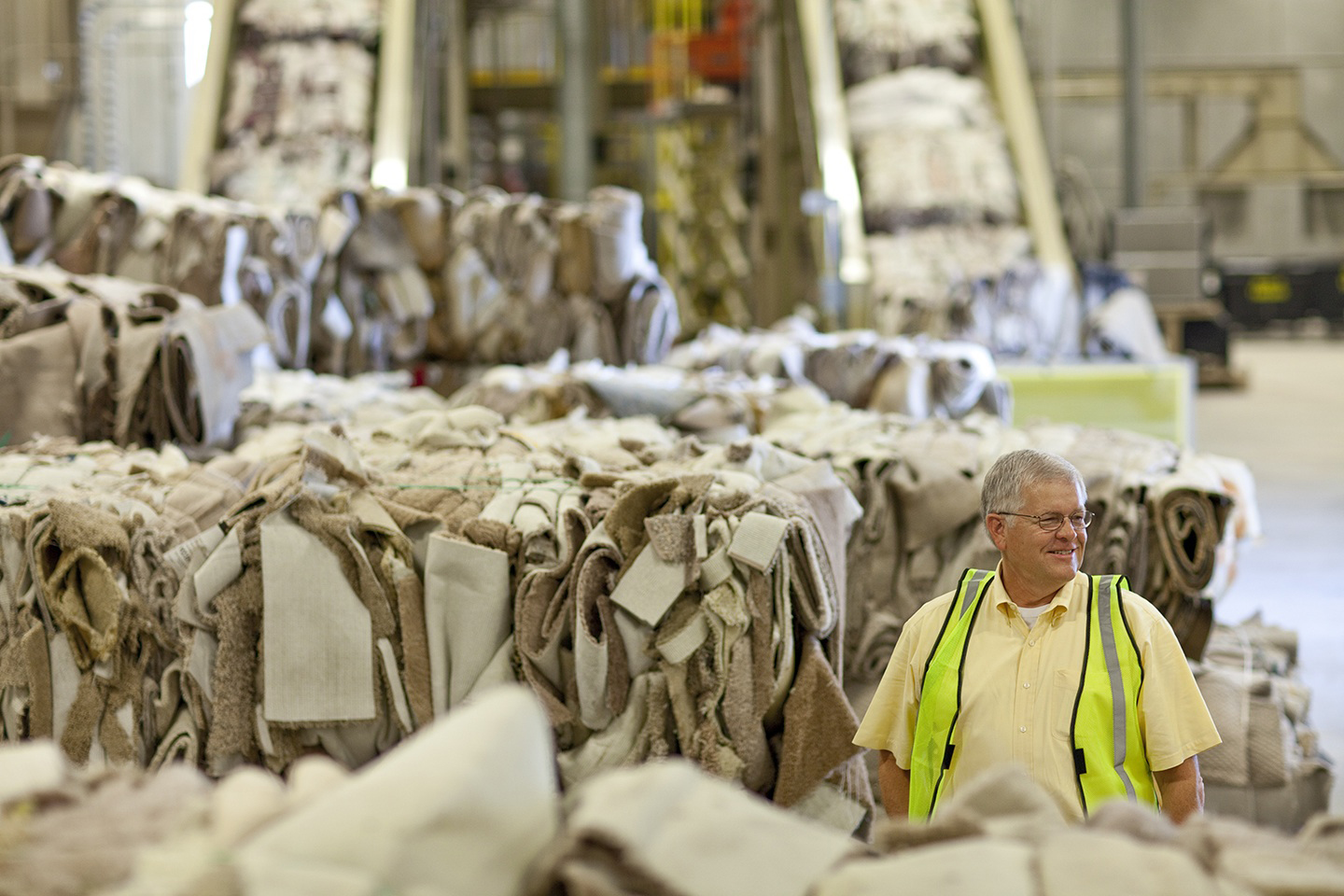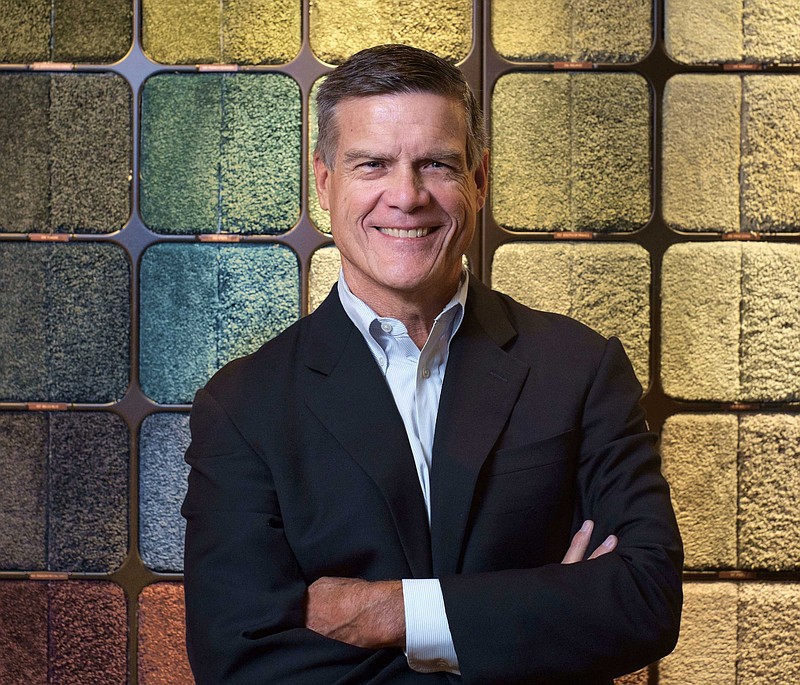 CUTLINE: Dalton, Ga.-based Shaw Industries will build a $17 million carpet recycling center in a former Ringgold, Ga. distribution facility, with plans to go operational in 2015. The flooring manufacturer says it has recycled more than 700 million pounds of carpet since it began its voluntary program in 2006.
CUTLINE: Dalton, Ga.-based Shaw Industries will build a $17 million carpet recycling center in a former Ringgold, Ga. distribution facility, with plans to go operational in 2015. The flooring manufacturer says it has recycled more than 700 million pounds of carpet since it began its voluntary program in 2006. In early April, a group of Mohawk Industries executives gathered in a tent in the parking lot of the flooring titan's Summerville, Georgia, plant as an array of 1,400 solar panels came online and began capturing the sun's energy through solar energy to push back out into the local electric power grid.
Mohawk, the world's largest floor covering manufacturer, also operates the world's largest integrated plastic bottle recycling center in Summerville, where 3 billion bottles a year are converted into materials used for new, reusable carpet components.
More Info
How carpet makers are going greenerMohawk Industries*World’s largest flooring manufacturer*World’s largest plastic bottle recycling facility*Recycles more than 3 billion plastic bottles annually*Carpets contain up to 100 percent recycled nylon*GreenWorks Center, leading-edge facility that extracts reusable material from used carpets*ReCover program, implemented to find and collect old carpet, regardless of manufacturer*On track to reduce total landfill impact by 25 percent by 2020, compared to 2009 base year*First flooring maker to appoint a chief sustainability officer and sustainability council*First in flooring to eliminate phthalates from products*Has 15 plants with zero waste-to-landfill impact*In 2012, top three Georgia companies in sustainability rankingsShaw Industries Group, Inc.*World’s largest carpet maker*World’s largest reclaimer of carpet*Diverts about 100 million pounds of carpet from landfills annually*Reclaimed more than 800 million pounds of carpet since 2006*Re2E facility, world’s first energy production plant powered specifically by unrecyclable carpet*Recycles around 160 million pounds of plastic bottles annually*Around 60 percent of total product sales now Cradle-to-Cradle certified, with aim toward 100 percent*Added solar panels to carpet tile plant in Cartersville, Georgia, in 2013Engineered Floors*Solution-dyed polyester fiber carpets*Consumes 30 percent less energy than traditional manufacturing*Generates 42 percent less greenhouse emissions*Requires 87 percent less water for manufacturingSources: Carpet America Recovery Effort 2013 annual report, Shaw Industries Group, Mohawk Industries and Engineered Floors
Just to the north in Ringgold, Georgia, rival Shaw Industries Group, Inc. is building a $20 million Evergreen facility where used carpets are broken down so their components can be used again to make new flooring or other useful, new products. "As the world's largest carpet manufacturer and a leading provider of hardwood, resilient and other flooring types, we understand the vast number of lives we touch with our products," says Vance Bell, chairman and CEO of Shaw.
And Engineered Floors, the newest carpet maker with longtime carpet king Bob Shaw at the helm, also hangs its hat on what it does - or more appropriately, what it doesn't do - to the environment. Grabbing market shares in chunks, Engineered Floors officials have said their attention to sustainability, to using less water and less power, have enabled them to cut costs and save resources and gain market share in the process, even competing alongside Dalton mainstays such as Mohawk, Shaw and Beaulieu America. The key, they say, has been spending less money on the front end and making more of it at the other.
For carpet and flooring manufacturers, there is growing pressure to be more environmentally sustainable. It starts with the government and trickles all the way down to consumers. In response, an industry that once understood waste as a necessary evil and accepted billions of square feet of man-made carpets winding up in landfills, has now come to terms with a new reality: Going green isn't just an option, it's a mandate.
Carpet is produced from petroleum-based products so recycling carpet can be like drilling for oil. One gallon of oil is lost for every three square yards of carpet that are put in landfills. That's because most carpet is a synthetic material made from oil. To make carpet, plastic pellets are heated and stretched to make fiber, which is then stitched together to make a variety of carpets and rugs.
For carpet manufacturers, there is also the pressure of government regulations, like the ones introduced by California lawmakers in 2011, targeted specifically at carpet, with the mandate that manufacturers divert used carpet away from landfills and submit sustainability reports explaining how they do it.
It's a monster task, considering the numbers.
According to the Carpet America Recovery Effort (a joint, government-industry non-profit organized in 2002 to address carpet sustainability issues), more than 5 billion pounds of old carpet a year were winding up in landfills back in 2003 - or, by some measurements, about 2 billion square feet, or more.
Now, however, CARE estimates at least 500 million pounds of old carpet are being diverted from landfills annually, with almost 200 million pounds of that being reclaimed and reused for new components.
And compared to 5 billion pounds of old carpet going into landfills in 2003, only 3.7 billion pounds were even discarded in 2013, meaning - after factoring in reclamation - only around 3 billion pounds of carpet was truly trashed, a 40 percent drop from 10 years before.
And those numbers continue to improve as carpet makers increasingly find ways to make money and recycle and reclaim post-consumer carpet, all at the same time.
Paul Murray, vice president of sustainability at Shaw, points out that being eco-friendly can't, and shouldn't, come at the expense of sound business sense.
"If it doesn't fit into a good business strategy, you should rethink what you're doing," he says. "I think in general, sustainability has to pay for itself."
Murray says sustainability program investments "should pass the same hurdles as normal capital."
"We've been doing this for a good amount of time, and we've been recycling products because it's a good business strategy," says Murray. "It's not: 'Let's throw money away and just recycle the carpet.'"
At Shaw, recycling and sustainability have become holistic visions, not just endeavors reserved for used carpet. Shaw has installed solar panels at its Cartersville, Georgia, plant and also collects around 160 million pounds of used plastic bottles every year, recycles them and uses the by-products in new carpets.
Shaw also built and now operates the world's first energy plant powered by old carpet that couldn't otherwise be recycled. Steam generated by the Re2E (Reclaim to Energy) plant, in turn, powers two of Shaw's carpet manufacturing plants, saving enough fossil fuel to power around 7,500 homes every year.
The carpet titan has reclaimed an estimated 800 million pounds of used carpet since 2006.
"You have to look at [sustainability] in its entirety," says Murray. "Not one part, but all parts."
The process of finding and reclaiming used carpet across the country has also spun off an almost entirely new industry, one that employs hundreds of people at either manufacturers (where new technologies and facilities have opened) or at independent firms, which specialize in finding, collecting and delivering used carpet to reclamation and recycling facilities.
The depth of Shaw's sustainability endeavors would have seemed foreign a few short years ago.
"Our customers are becoming more and more sophisticated, and they're asking for more information," Murray says. "In 1992, there were no customers asking."
Today, not all types of carpet can be re-used or broken down for energy because of the types of fibers used in original construction. And while some carpets have components good for new carpet tile production, others have materials useful in automotive manufacturing.
Over time, the industry's goal is to find ways to make all products recyclable. Shaw wants to eventually manufacture 100 percent of its products with curate-to-cradle designation, or with emphasis on safe and healthy products, with a focus on reused materials, social fairness and optimal and efficient use of resources.
Murray says so far Shaw has not only found ways to make going greener cost-effective, the company believes cutting down its energy and resource consumption, finding ways to make taking its post-consumer carpets back, and re-tooling them into new, usable materials and choosing innovation over the status quo will result in the company being set up for success in the long-term.
"We believe that if you put all those together, we are significantly more efficient because of our sustainability efforts," he says.
At Shaw, Bell emphasizes the company's holistic approach, "which begins by designing with the end in mind and is carried through our manufacturing, delivery, sales and marketing."
But the ultimate mark of whether Shaw is succeeding, he says, is "what happens to a product at the end of its useful life on the floors of homes and businesses."
